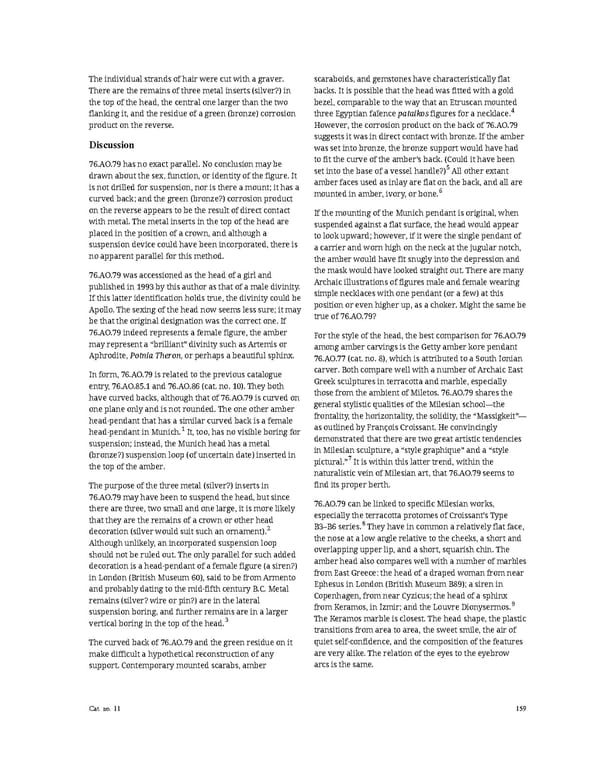The individual strands of hair were cut with a graver. scaraboids, and gemstones have characteristically flat There are the remains of three metal inserts (silver?) in backs. It is possible that the head was fitted with a gold the top of the head, the central one larger than the two bezel, comparable to the way that an Etruscan mounted flanking it, and the residue of a green (bronze) corrosion three Egyptian faïence pataikos figures for a necklace.4 product on the reverse. However, the corrosion product on the back of 76.AO.79 Discussion suggests it was in direct contact with bronze. If the amber was set into bronze, the bronze support would have had 76.AO.79 has no exact parallel. No conclusion may be to fit the curve of the amber’s back. (Could it have been set into the base of a vessel handle?)5 All other extant drawn about the sex, function, or identity of the figure. It amber faces used as inlay are flat on the back, and all are is not drilled for suspension, nor is there a mount; it has a mounted in amber, ivory, or bone.6 curved back; and the green (bronze?) corrosion product on the reverse appears to be the result of direct contact If the mounting of the Munich pendant is original, when with metal. The metal inserts in the top of the head are suspended against a flat surface, the head would appear placed in the position of a crown, and although a to look upward; however, if it were the single pendant of suspension device could have been incorporated, there is a carrier and worn high on the neck at the jugular notch, no apparent parallel for this method. the amber would have fit snugly into the depression and 76.AO.79 was accessioned as the head of a girl and the mask would have looked straight out. There are many published in 1993 by this author as that of a male divinity. Archaic illustrations of figures male and female wearing If this latter identification holds true, the divinity could be simple necklaces with one pendant (or a few) at this Apollo. The sexing of the head now seems less sure; it may position or even higher up, as a choker. Might the same be be that the original designation was the correct one. If true of 76.AO.79? 76.AO.79 indeed represents a female figure, the amber For the style of the head, the best comparison for 76.AO.79 may represent a “brilliant” divinity such as Artemis or among amber carvings is the Getty amber kore pendant Aphrodite, Potnia Theron, or perhaps a beautiful sphinx. 76.AO.77(cat. no. 8), which is attributed to a South Ionian In form, 76.AO.79 is related to the previous catalogue carver. Both compare well with a number of Archaic East entry, 76.AO.85.1 and 76.AO.86 (cat. no. 10). They both Greek sculptures in terracotta and marble, especially have curved backs, although that of 76.AO.79 is curved on those from the ambient of Miletos. 76.AO.79 shares the one plane only and is not rounded. The one other amber general stylistic qualities of the Milesian school—the head-pendant that has a similar curved back is a female frontality, the horizontality, the solidity, the “Massigkeit”— head-pendant in Munich.1It, too, has no visible boring for as outlined by François Croissant. He convincingly suspension; instead, the Munich head has a metal demonstrated that there are two great artistic tendencies (bronze?) suspension loop (of uncertain date) inserted in in Milesian sculpture, a “style graphique” and a “style pictural.”7 It is within this latter trend, within the the top of the amber. naturalistic vein of Milesian art, that 76.AO.79 seems to The purpose of the three metal (silver?) inserts in find its proper berth. 76.AO.79 may have been to suspend the head, but since 76.AO.79 can be linked to specific Milesian works, there are three, two small and one large, it is more likely especially the terracotta protomes of Croissant’s Type that they are the remains of a crown or other head B3–B6 series.8 They have in common a relatively flat face, decoration (silver would suit such an ornament).2 Although unlikely, an incorporated suspension loop the nose at a low angle relative to the cheeks, a short and should not be ruled out. The only parallel for such added overlapping upper lip, and a short, squarish chin. The decoration is a head-pendant of a female figure (a siren?) amber head also compares well with a number of marbles in London (British Museum 60), said to be from Armento from East Greece: the head of a draped woman from near and probably dating to the mid-fifth century B.C. Metal Ephesus in London (British Museum B89); a siren in remains (silver? wire or pin?) are in the lateral Copenhagen, from near Cyzicus; the head of a sphinx from Keramos, in İzmir; and the Louvre Dionysermos.9 suspension boring, and further remains are in a larger The Keramos marble is closest. The head shape, the plastic vertical boring in the top of the head.3 transitions from area to area, the sweet smile, the air of The curved back of 76.AO.79 and the green residue on it quiet self-confidence, and the composition of the features make difficult a hypothetical reconstruction of any are very alike. The relation of the eyes to the eyebrow support. Contemporary mounted scarabs, amber arcs is the same. Cat. no. 11 159
 Ancient Carved Ambers in the J. Paul Getty Museum Page 168 Page 170
Ancient Carved Ambers in the J. Paul Getty Museum Page 168 Page 170